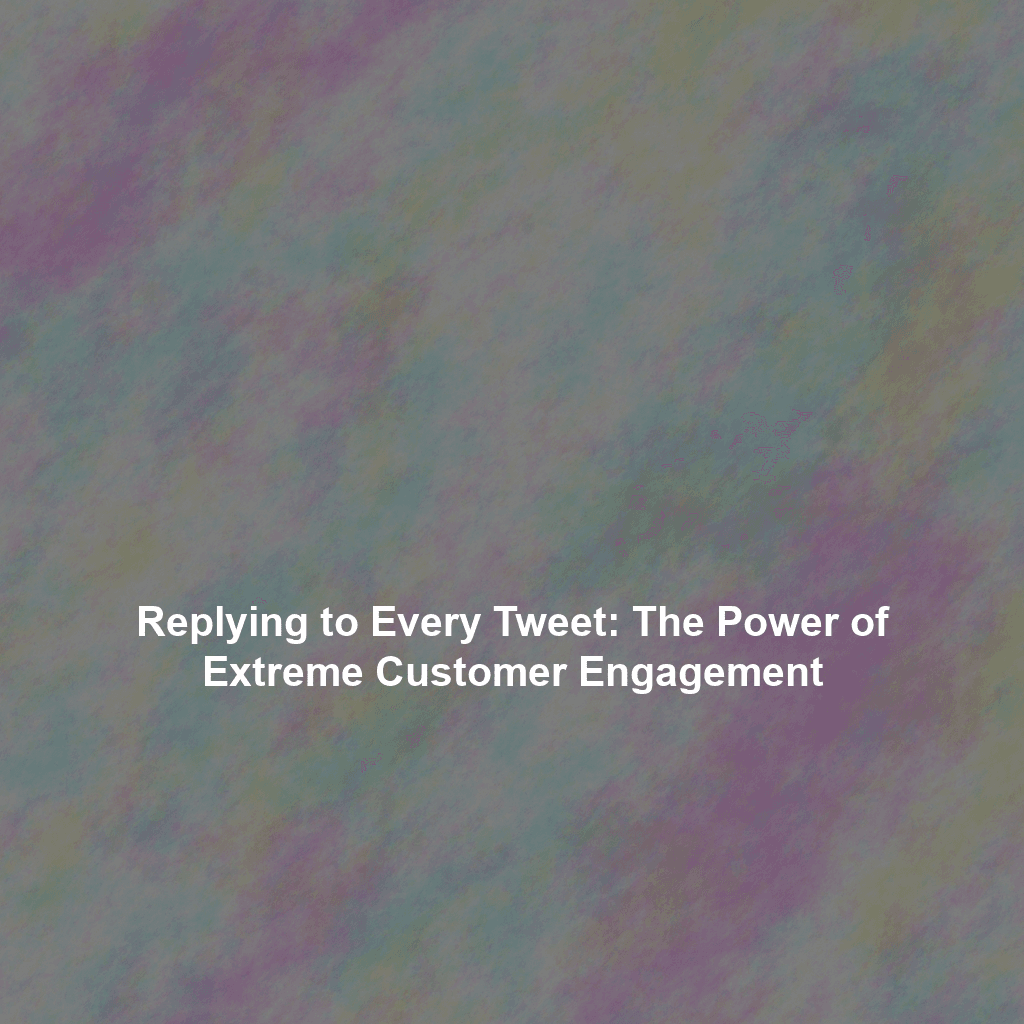In the wild west of digital marketing, you often find yourself needing to experiment. You are looking for that next big thing to separate yourself from the crowd. Most marketers follow a well-trodden path, but what if the real growth hacks lie in the unexplored territory of weird marketing strategies? One such tactic, bordering on the obsessive, is replying to every single tweet that mentions your brand. It sounds exhausting, potentially overwhelming, and perhaps utterly insane. But could it actually be a stroke of genius? Let’s dive into the pros, cons, and ROI to see if this extreme customer engagement strategy is worth the investment.
The Allure of Extreme Customer Engagement
In a world where brands often seem detached and impersonal, extreme customer engagement stands out like a neon sign. It’s a powerful way to show that you’re listening, you care, and you’re willing to go the extra mile. But is it scalable? Is it sustainable? And most importantly, does it actually drive growth?
Why This Could Be Brilliant
- Humanizing Your Brand: Replying to every tweet, even seemingly insignificant ones, turns your brand into a person, not just a logo. It shows there’s a real human behind the screen who cares about what customers are saying.
- Building Brand Loyalty: When you acknowledge and respond to customers, you make them feel valued. This fosters a sense of loyalty and encourages them to continue engaging with your brand.
- Turning Critics into Advocates: Addressing negative feedback quickly and publicly can turn disgruntled customers into your biggest advocates. It shows you’re willing to listen and take action.
- Boosting Brand Visibility: Every reply increases your brand’s visibility on Twitter. More tweets mean more opportunities for your content to be seen and shared.
- Direct Feedback Loop: Replying to every tweet gives you a direct line of sight into customer sentiment. You can identify trends, spot problems early, and gather valuable feedback to improve your products or services.
- Search Engine Optimization (SEO) Benefits: While not a direct ranking factor, increased brand mentions and engagement on social media can indirectly improve your search engine rankings by increasing brand awareness and website traffic.
The Dark Side of Replying to Absolutely Everything
Of course, no marketing strategy is without its drawbacks. Replying to every tweet is a resource-intensive endeavor, and it comes with its own set of potential pitfalls.
The Downsides You Need to Consider
- Resource Intensive: Monitoring Twitter 24/7 and crafting personalized responses to every tweet requires a significant investment of time and personnel.
- Potential for Misinterpretation: Tone can be difficult to convey in 280 characters. There’s always a risk of your message being misinterpreted, leading to unintended offense or confusion.
- Trolling and Spam: You’ll inevitably encounter trolls and spam accounts. Responding to them can waste your time and potentially even amplify their message.
- Dealing with Negative Feedback: Publicly addressing negative feedback requires a thick skin and a well-defined crisis communication plan. A poorly handled response can quickly escalate into a PR disaster.
- Setting Unrealistic Expectations: Once you start replying to every tweet, customers may come to expect that level of responsiveness. Failing to maintain that standard could lead to disappointment and frustration.
- Burnout: The constant monitoring and engagement can be mentally draining for your social media team. It’s important to ensure they have adequate support and resources to avoid burnout.
Is the Investment Worth the Reward? Calculating the ROI
The ultimate question is whether the potential benefits outweigh the costs. Calculating the ROI of replying to every tweet is challenging, but not impossible. Here’s a framework to consider:
Key Metrics to Track
- Brand Mentions: Monitor the number of brand mentions before and after implementing the strategy.
- Engagement Rate: Track the number of likes, retweets, and replies your tweets receive.
- Website Traffic: Analyze the traffic coming from Twitter to your website.
- Lead Generation: Measure the number of leads generated directly or indirectly from Twitter.
- Customer Satisfaction: Conduct surveys or monitor social media sentiment to gauge customer satisfaction.
- Conversion Rates: See if engagement on Twitter leads to more sales or sign-ups.
Tools and Techniques for Measuring ROI
- Social Media Analytics Tools: Use tools like Sprout Social, Hootsuite, or Buffer to track your social media metrics.
- Google Analytics: Monitor website traffic and conversions from Twitter.
- Social Listening Tools: Use tools like Mention or Brand24 to track brand mentions and sentiment.
- Customer Surveys: Conduct surveys to gather feedback on customer satisfaction and brand perception.
- A/B Testing: Experiment with different response styles and frequencies to see what works best.
Alternatives: Smarter, Not Harder
Replying to *every* tweet may not be feasible or desirable for every brand. Here are some alternative strategies that can achieve similar results with less effort:
- Prioritize Key Influencers: Focus your efforts on engaging with influential accounts in your niche.
- Address Negative Feedback Promptly: Make it a priority to respond to negative feedback quickly and effectively.
- Create a Branded Hashtag: Encourage customers to use a branded hashtag and monitor it for mentions.
- Automate Repetitive Tasks: Use chatbots or automated tools to handle simple inquiries.
- Develop a Community Forum: Create a dedicated forum where customers can ask questions and interact with each other.
Conclusion: Is This Weird Marketing Trick Right For You?
Replying to every tweet is undoubtedly a bold and unconventional marketing strategy. While it has the potential to humanize your brand, build loyalty, and boost visibility, it also comes with significant costs and risks. Before diving in headfirst, carefully consider your resources, your target audience, and your overall marketing goals. If you’re willing to invest the time and effort, and if you can manage the potential downsides, this weird marketing trick might just be the key to unlocking explosive growth. But, if you’re a small company or have limited resources, a more targeted and strategic approach to social media engagement may be a more sustainable and effective solution. Remember, the best marketing strategies are the ones that are tailored to your specific needs and circumstances. Don’t be afraid to experiment, but always measure your results and be prepared to adapt your approach as needed. Good luck, and may your tweets be ever in your favor!
 Skip to content
Skip to content

